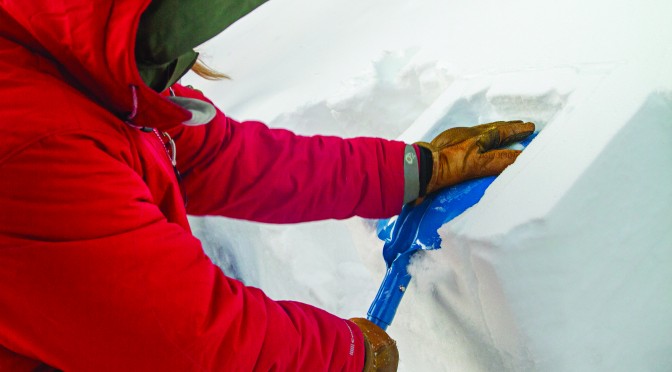by David Tucker
Picture this: you and a couple of friends have been touring all morning, leisurely approaching your objective as the sun swings around the southern sky. You checked the report and conditions are moderately dangerous, but the terrain you’ve selected is relatively low-angle, so you and your partners decide the coast is clear, full steam ahead.
Once your team is above the bowl you plan to ski, and ready to drop in, everyone double-checks gear and confirms one final time that the slope is good to go. The gentleman you are, you let a friend drop in first.
And then the slope slides.
Your team is experienced and prepared, so everyone switches quickly into rescue mode. Once you pick up a signal from your buried partner, you hone in on her location. But you got a new beacon for Christmas and haven’t taken the time to learn its ins and outs. You’re now useless. I’ll dig, you think, but your shovel is old and the handle sticks, meaning it’s half as long as it should be and inefficient. As a last resort, you reach into your pack for your probe. But you’re carrying more gear than usual and with gloves on, have trouble removing your probe from your overstuffed pack.
Luckily, the rest of your team was on point. Your partner’s only partially buried, so she’s dug out and safe in a few short minutes—time to debrief. Even though you had all the gear, your lack of pre-trip preparation rendered it useless when the shit hit the fan. Here’s what you should have done.
Practice with New Gear
Or old gear, for that matter. If you upgrade your safety tools, make sure you know how to use them. There are great new options on the market today, but they only work as well as their rescuer. The more you know about your equipment, the better. The Gallatin national Forest Avalanche Center (GNFAC) buries beacons at Beall Park in Bozeman, and Bridger Bowl ski patrol does the same below the South Bowl. These are great resources to take advantage of. The next time you’re up at the hill, take an hour to practice using your equipment in zero-consequence terrain.
This goes for your shovel and probe as well. Even small changes in materials and design can confuse a new user, costing a buried victim precious seconds. New gear might have features your old stuff didn’t, and if you’re unfamiliar with them, you might be exposing partners to unnecessary risk. Practice, practice, practice.
Dial in Your Kit
This is important and usually overlooked. Even if you are familiar and well-versed in your gear, the way it is arranged in your pack might have consequences. For instance, I recently started taking more pictures in the backcountry, meaning I carry a camera and case now. This takes up a lot of space and impedes my ability to efficiently remove items from my pack. I was recently practicing with some new gear and removing my shovel and probe turned into a total junk-show. I got frustrated and lost focus. When you’re packing gear, make sure the rescue tools slide out easily and are at hand, not buried deep. Most packs have tool-specific pockets now, but even so, a tightly packed bag can make retrieval difficult. Run at-home tests before venturing into the backcountry.
Take a Course
Even if you have already. Do yourself a favor and take refreshers every winter. Even if you just stop by a free hour-long presentation, you’ll get new information and learn about current conditions. Protocols change, technology develops, and trends shift—stay up to date. GNFAC runs seminars all over town, and MSU hosts multi-day intro and advanced level courses for cheap. If you’re ready to take the next step, local guides like Montana Alpine Adventures and Beartooth Powder Guides have courses all winter long.
It’s never too early—nor late—to refresh skills, procedures, and education. We’ll be skiing well into May (hopefully), so you have more than enough time to get the experience you need to stay safe.

